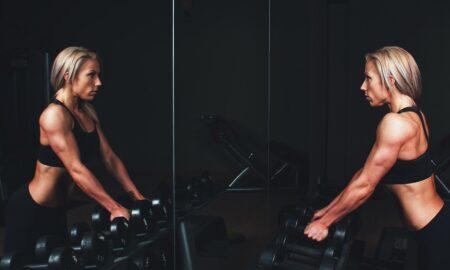Face it, you want your bench press to go huge. You know, red zone’like four big wheels on each side of an Olympic bar growling that guttural roar as you crank out rep after powerful rep. But it seems as if it’s taking forever to get there. You’ve been stuck at the same paltry weight for months. Is the solution more assistance work? Partials? Explosive reps?
Trainees don’t realize that it’s not weak pecs, delts or triceps that prevent leaps in pressing prowess. Most of the time it’s underdevelopment of the smaller muscles that support the shoulder joint, a.k.a. the rotator cuff. Those four key muscles’the supraspinatus, the infraspinatus, the teres minor and the subscapularis’are often neglected to the point of stalled pressing poundages, not to mention chronic injury and unstable shoulder joints.
A few weeks of specific rotator cuff work’with fairly light dumbbells’can have you adding 10, 20 or 30 pounds to your bench press and overhead-pressing poundages with ease. And more later as your ball-and-socket joints morph into industrial-strength jackhammers. It’s almost as simple as waving bye-bye’at least, that’s what the key rotator cuff movement, which is also known as an L flye, looks like.
You may have seen people sitting on the floor next to a flat bench performing L flyes with a dumbbell. Their arm is out to the side on the same plane as the torso, elbow bent at a right angle and supported on the bench’like they’re waving’dumbbell in hand. The forearm rotates down and forward, touching the bench, then moves back up to the waving, or L, position.
It’s a simple move for a complex group of muscles that may be the hidden weak link that’s keeping your bench press poundage in the toilet. Thanks to the Shoulder Horn, you can do that move more precisely and more comfortably, training both arms at the same time and with complete stability of the upper arm’no bench necessary.
Once you start using the Shoulder Horn for only two or three sets twice a week, you’ll feel your shoulders becoming more powerful and stable almost immediately. Your pressing poundages will start moving up again, and a lot of the aches and pains in your shoulder joints will disappear. It’s truly an upper-body power tool for the strength surge you’ve been looking for. (And you’ll sleep better too because that deep ache in your shoulders isn’t waking you up anymore when you roll over on your side.)
Still, there’s more to a superior rotator cuff structure than just strengthening those shoulder stabilizers. You also have to know how the shoulders work and what exercises in your routine could be causing shoulder damage. Proper performance of exercises that stress your shoulders is also a key to preventing injuries, no matter how strong your rotators are. For example, a lot of people do lateral raises in a way that can damage the shoulder joints.
The book that gives you all the info you need to bulletproof your shoulders and keep them injury free is The 7-Minute Rotator Cuff Solution by Joseph Horrigan, D.C., and Jerry Robinson. It’s a large-format manual with more than 130 pages and plenty of exercise and anatomical illustrations that will provide you with the shoulder-stabilizing and -strengthening info you need to blast up bigger weights and develop the chest, delt and triceps you’ve been after without a hint of shoulder damage. With this tome you’ll learn:
How the rotator cuff muscles work and where they are (excellent illustrations).
What can go wrong with those muscles and how it happens’from fibrosis to calcium deposits to stiffness.
Specific rotator cuff exercises and how to do them (the Shoulder Horn is a perfect fit).
Stretching exercises for your pecs, delts, biceps and external rotators to keep you injury free and growing as fast as possible. Weight-training exercises to modify or avoid to protect your shoulders. (Did you know that types of some upright rows can trash your shoulder joints?)
Specific training programs (more excellent illustrations).
Important information for athletes, along with rehab routines for sports-specific injuries.
The complete bodybuilder’s injury-prevention routine.
Technical info, from detailed biomechanics to pathology. (Author Joseph Horrigan is a doctor of chiropractic who owns and operates the Soft Tissue Center in Southern California; he also pens IRON MAN’s popular Sportsmedicine column.)
Shoulder injury is one of the major reasons trainees have to sacrifice gains on many of the most important strength- and mass-building exercises’from bench presses to chins to pulldowns to squats (yes, you have to have proper shoulder flexibility to hold a bar behind your neck and squat properly, without excessive forward lean). You’ll be amazed at how much better your shoulders feel and how much more weight you can hoist once you start training your rotator cuff muscles regularly and properly with the Shoulder Horn and incorporating the info in The 7-Minute Rotator Cuff Solution into your program. All it takes is a couple of sets added to your delt or chest routine twice a week.
The Shoulder Horn retails for $59.95, and the book goes for $29.95. It’s right around $90, total, but you can get both for only $69.95 (you save $19.95). That’s a small price to pay for bigger gains in muscle size and pressing poundages, not to mention bulletproof shoulders that are pain free and power-packed.
To get the special IM Research Team price of only $59.95 plus shipping and handling from Home Gym Warehouse, you must call (800) 447-0008. Ask for the Research Team Rotator Cuff Combo. You need to know your T-shirt size to get the proper Shoulder Horn fit and then get ready for your bench press poundages to soar! IM




















You must be logged in to post a comment Login